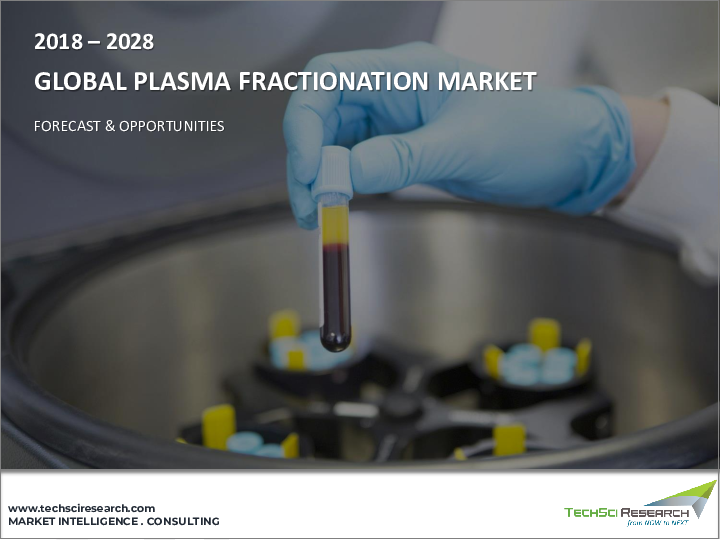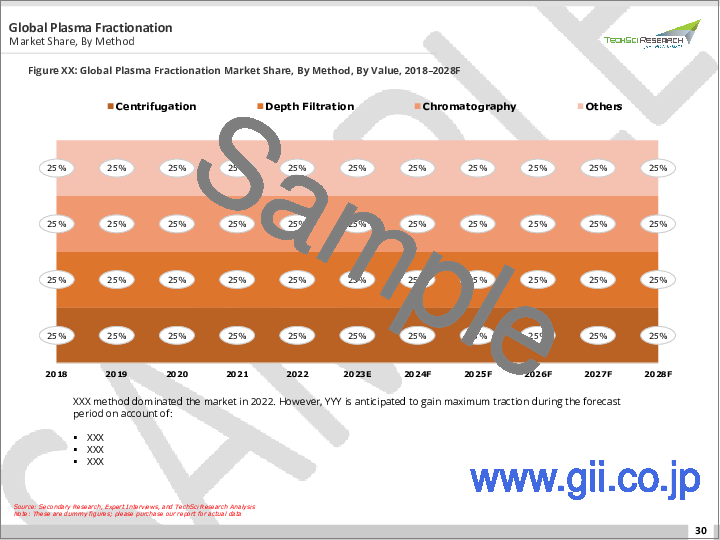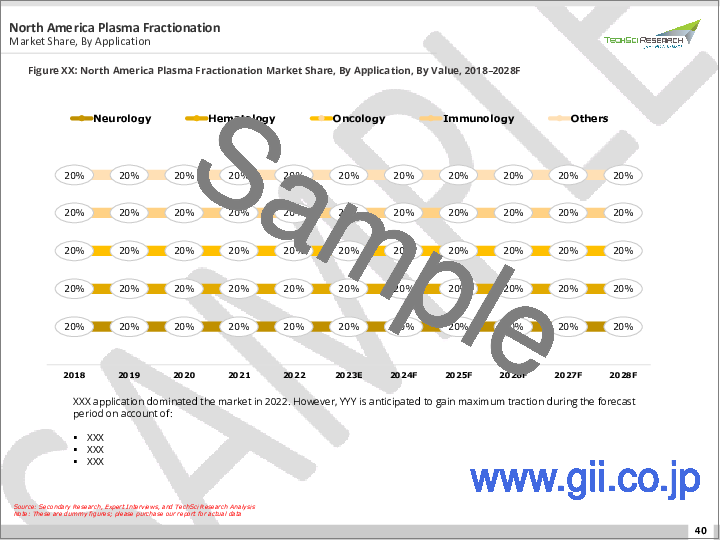|
|
市場調査レポート
商品コード
1255246
血漿分画市場- 世界の産業規模、シェア、動向、機会、および予測、2018-2028年:製品別、方法別、用途別、エンドユーザー別、地域別セグメント、競合Plasma Fractionation Market - Global Industry Size, Share, Trends, Opportunity, and Forecast, 2018-2028 Segmented by Product, By Method, By Application, By End User, By Region, and Competition |
||||||
|
● お客様のご希望に応じて、既存データの加工や未掲載情報(例:国別セグメント)の追加などの対応が可能です。 詳細はお問い合わせください。 |
|||||||
| 血漿分画市場- 世界の産業規模、シェア、動向、機会、および予測、2018-2028年:製品別、方法別、用途別、エンドユーザー別、地域別セグメント、競合 |
|
出版日: 2023年04月01日
発行: TechSci Research
ページ情報: 英文 113 Pages
納期: 2~3営業日
|
- 全表示
- 概要
- 目次
血漿分画の世界市場は、予測期間中に目覚ましい成長を遂げると予測されています。
これは、免疫疾患や重大な病気など、あらゆる年齢層で慢性疾患の有病率が高まっていることと、慢性疾患の治療のための免疫グロブリンの需要が増加していることに起因しています。さらに、血液疾患や呼吸器疾患の有病率の増加や、病気を治すための技術の進歩により、世界のさまざまな地域で血漿分画の需要が著しく増加しています。さらに、さまざまな種類の慢性疾患にかかりやすい老年人口が世界中で増加していることも、血漿分画の需要をさらに高め、2028年までの市場成長を促進すると予想されます。また、慢性疾患の診断に血漿分画を使用する利点についての認識が世界中で高まっていることも、予測期間中の血漿分画市場をさらに後押しすると予想されます。さらに、免疫グロブリンに関連する研究開発活動の増加は、歯科用輪郭形成の需要をさらに増加させると予想されています。Statistaによると、2022年現在、ベルナール・スーリエ症候群の患者の約51パーセントは女性で、49パーセントは男性でした。
免疫不全症の有病率の高まり
血液疾患や免疫疾患の発生率の増加、アルブミンや免疫グロブリンなどの重要な血漿製品の適応外使用は、予測期間中の市場成長を促進する主な要因です。同様に、血漿分画として医療分野で免疫グロブリンやα-1-アンチトリプシンの使用が増加していることも、市場の成長を促進する要因になります。同様に、血漿関連療法に対する需要の増加は、新たな疾患の治療にとって重要です。近年、肺疾患や肝疾患の治療のために、α-1-アンチトリプシン蛋白のようなプロテアーゼ阻害剤の使用量が増加しており、このことが、予測期間において、市場に有利な成長をもたらすと予想されます。例えば、アルツハイマー病協会の2021年3月の報告書によると、米国では65歳以上の約620万人がアルツハイマー病関連の認知症と共存しています。
新しい技術の開発
主要企業は、確実な結果をもたらすさまざまな治療法に投資しています。メーカーは、IgA、プラスミン、セルロプラスミンなどの新しい療法に注目しています。このことは、予測期間中に有利な成長をもたらすと期待されています。ヘルスケア分野の急速な変化は、継続的な技術革新とともに、北米のような発展途上国での血漿分画の需要を加速させるものと思われます。2019年には、血友病と診断された人が世界で約195,263人、フォンウィルブランド病と診断された人が80,302人いました。
最近の開発状況
- 例えば、2021年3月、WHOの必須医薬品モデルリスト別と、血漿由来医薬品(PDMP)がいくつか含まれており、保健システムにおける必須要件に対処するために最も効率的かつ安全だと考えられる医薬品として特定し、低・中所得国におけるPDMPの供給増加に関する最善のガイドラインを提供します。
- 例えば、2020年4月、COVID-19の治療に有効な血漿由来医薬品を創出するため、CSLベーリング&武田薬品工業株式会社は、Biotest、BPL、LFB、Octapharmaと協働しました。
- 例えば、2019年4月には、血友病患者を支援する長期的な取り組みのもと、血漿由来治療薬のサプライヤーであるGrifols International SAが、血友病患者の治療のために血液凝固因子薬(1億国際単位)を提供しました。
対応可能なカスタマイズ
与えられた市場データをもとに、TechSci Researchは企業の特定のニーズに応じてカスタマイズを提供します。本レポートでは、以下のカスタマイズが可能です。
企業情報
- 追加市場プレイヤー(最大5社)の詳細分析およびプロファイリング
目次
第1章 概要
- 市場の定義
- 市場の範囲
- 対象市場
- 研究対象年
- 主な市場セグメンテーション
第2章 調査手法
- 調査目的
- ベースライン調査手法
- 主要産業パートナー
- 主な協会と二次情報
- 調査手法
- データの三角測量と検証
- 前提条件と限界
第3章 エグゼクティブサマリー
- 市場概要
- 主要市場セグメンテーションの概要
- 主要市場プレイヤーの概要
- 主要地域/国の概要
- 市場促進要因・課題・動向
第4章 VOC (顧客の声)
第5章 血漿分画の世界市場の展望
- 市場規模・予測
- 数量別
- 市場シェアと予測
- 製品別(アルブミン、免疫グロブリン、凝固因子、プロテアーゼインヒビター、その他)
- 方法別(遠心分離、深層ろ過、クロマトグラフィー、その他)
- 用途別(神経内科、血液内科、腫瘍内科、免疫内科、その他)
- エンドユーザー別(病院・診療所、学術・調査機関、その他)
- 地域別
- 企業別(2022年)
- マーケットマップ
- 製品別
- 方法別
- 用途別
- エンドユーザー別
- 地域別
第6章 北米の血漿分画市場の展望
- 市場規模・予測
- 数量別
- 市場シェアと予測
- 製品別
- 方法別
- 用途別
- エンドユーザー別
- 国別
- 北米:国別分析
- 米国
- カナダ
- メキシコ
第7章 欧州の血漿分画市場の展望
- 市場規模・予測
- 数量別
- 市場シェアと予測
- 製品別
- 方法別
- 用途別
- エンドユーザー別
- 国別
- 欧州:国別分析
- フランス
- ドイツ
- 英国
- イタリア
- スペイン
第8章 アジア太平洋地域の血漿分画市場の展望
- 市場規模・予測
- 数量別
- 市場シェアと予測
- 製品別
- 方法別
- 用途別
- エンドユーザー別
- 国別
- アジア太平洋地域の:国別分析
- 中国
- インド
- 日本
- 韓国
- オーストラリア
第9章 南米の血漿分画市場の展望
- 市場規模・予測
- 数量別
- 市場シェアと予測
- 製品別
- 方法別
- 用途別
- エンドユーザー別
- 国別
- 南米:国別分析
- ブラジル
- アルゼンチン
- コロンビア
第10章 中東・アフリカの血漿分画市場の展望
- 市場規模・予測
- 数量別
- 市場シェアと予測
- 製品別
- 方法別
- 用途別
- エンドユーザー別
- 国別
- MEA:国別分析
- 南アフリカ血漿分画
- サウジアラビア血漿分画
- UAE血漿分画
- トルコ血漿分画
- エジプト血漿分画
第11章 市場力学
- 促進要因
- 課題
第12章 市場の動向と開拓
- 最近の動向
- M&A(合併・買収)
- 製品発表
第13章 競合情勢
- Grifols S.A.
- Octapharma AG
- Intas Pharmaceuticals Ltd
- LFB S.A.
- Takeda Pharmaceutical Company Limited
- CSL Limited
- Biotest AG
- Kedrion S.p.A
- Bio Products Laboratory Ltd.'
- Bharat Serums and Vaccines Limited
第14章 戦略的な提言
The Global Plasma Fractionation Market is anticipated to witness impressive growth during the forecast period. This can be ascribed to the growing prevalence of chronic diseases among all age groups, such as immunological disorders and grave diseases, along with increasing demand for immunoglobulins for the treatment of chronic diseases. Additionally, the growing prevalence of blood and respiratory disorders due to and growing advancement in technology to cure diseases has significantly increased the demand for plasma fractionation across different parts of the globe. Additionally, the growing geriatric population across the globe, which is susceptible to different kinds of chronic diseases, is further expected to increase the demand for plasma fractionation, thereby fuelling market growth through 2028. Besides, growing awareness about the advantages of using plasma fractions for the diagnosis of chronic diseases across the globe is further expected to support the plasma fractionation market during the forecast period. Furthermore, increasing research and development activities related to immunoglobulin are further expected to increase the demand for dental contouring. According to Statista, as of 2022, around 51 percent of patients with Bernard Soulier syndrome were female, while 49 percent were male.
Growing Prevalence of Immunodeficiency disorder
The increasing incidence of blood and immune disorders and off-label usage of critical plasma products like albumins and immunoglobulins is the main factors that will boost the market growth during the forecast period. Similarly, the rising use of immunoglobulins and alpha-1-antitrypsin in the medical sector as a plasma fraction will propel the growth of the market. Similarly, increasing demand for plasma-related therapies is important for the treatment of new diseases. In the present years, usage of protease inhibitors like alpha-1-antitrypsin protein is increased for the treatment of lung diseases and hepatic diseases; this, in turn, is expected to create lucrative growth for the market in the forecast period. For instance, according to the March 2021 report of the Alzheimer's Association, approximately 6.2 million people of age 65 years and more are living with Alzheimer's-related dementia in the United States.
Development of New Technologies
Major players are investing in different therapies that will produce reliable results. Manufacturers are focusing on new therapies such as IgA, Plasmin, and Ceruloplasmin. This, in turn, is expected to create lucrative growth in the forecast period. A rapid change in the healthcare sector, along with continuous technological innovation, shall accelerate demand for plasma fractionation in developing countries like North America. In 2019, there were around 195,263 people worldwide who had been diagnosed with hemophilia and 80,302 who had been diagnosed with von Willebrand disease.
Market Segmentation
The global plasma fractionation market can be segmented by product, method, application, end-user, and by region. Based on product, the market can be segmented into Albumin, Immunoglobulins, Coagulation Factors, Protease Inhibitors, and Others. Based on the method, the market can be differentiated into Centrifugation, Depth Filtration, Chromatography, and Others. Based on application, the market can be grouped into Neurology, Hematology, Oncology, Immunology, and Others. Based on end users, the market can be segmented into Hospitals & Clinics, Academic & Research Institutes, and Others. Regionally, North America dominated the market among Asia Pacific, Europe, Middle East & Africa, and South America. Among the different countries, the United States dominated the global plasma fractionation market on account of the growing demand for new therapies for the treatment of chronic diseases in the country.
Market Players
Grifols S.A., Octapharma AG, Intas Pharmaceuticals Ltd, LFB S.A., Takeda Pharmaceutical Company Limited, CSL Limited, Biotest AG, Kedrion S.p.A, Bio Products Laboratory Ltd.', Bharat Serums and Vaccines Limited are some of the leading players operating in the Global Plasma Fractionation Market.
Recent Developments
- For instance, in March 2021, according to the WHO Model List of essential medicines includes several plasma-derived medicinal products (PDMPs), identifying them as drugs thought to be the most efficient and secure for addressing the essential requirements in a health system and provide the best guidelines on increased supply of PDMPs in low & middle-income countries
- For instance, in April 2020, to create a viable plasma-derived medication for treating COVID-19, CSL Behring & Takeda Pharmaceutical Company Ltd. collaborated with Biotest, BPL, LFB, and Octapharma.
- For instance, in April 2019, under a long-term initiative to support people with hemophilia, Grifols International SA, a supplier of plasma-derived therapeutics, provided blood clotting factor medications (100 million international units) for the treatment of hemophilic patients.
Report Scope
In this report, global plasma fractionation market has been segmented into the following categories, in addition to the industry trends, which have also been detailed below:
Plasma Fractionation Market, By Product:
- Albumin
- Immunoglobulins
- Coagulation Factors
- Protease Inhibitors
- Others
Plasma Fractionation Market, By Method:
- Centrifugation
- Depth Filtration
- Chromatography
- Others
Plasma Fractionation Market, By Application:
- Neurology
- Hematology
- Oncology
- Immunology
- Others
Plasma Fractionation Market, By End User:
- Hospitals & Clinics
- Academic & Research Institutes
- Others
Plasma Fractionation Market, By Region:
- North America
- United States
- Canada
- Mexico
- Europe
- France
- Germany
- United Kingdom
- Italy
- Spain
- Asia Pacific
- China
- India
- Japan
- South Korea
- Australia
- South America
- Brazil
- Argentina
- Colombia
- Middle East & Africa
- South Africa
- Saudi Arabia
- UAE
- Turkey
- Egypt
Competitive Landscape
Company Profiles: Detailed analysis of the major companies present in Global Plasma Fractionation Market.
Available Customizations
With the given market data, TechSci Research offers customizations according to a company's specific needs. The following customization options are available for the report:
Company Information
- Detailed analysis and profiling of additional market players (up to five).
Table of Contents
1. Product Overview
- 1.1. Market Definition
- 1.2. Scope of the Market
- 1.2.1. Markets Covered
- 1.2.2. Years Considered for Study
- 1.2.3. Key Market Segmentations
2. Research Methodology
- 2.1. Objective of the Study
- 2.2. Baseline Methodology
- 2.3. Key Industry Partners
- 2.4. Major Association and Secondary Sources
- 2.5. Forecasting Methodology
- 2.6. Data Triangulation & Validation
- 2.7. Assumptions and Limitations
3. Executive Summary
- 3.1. Overview of the Market
- 3.2. Overview of Key Market Segmentations
- 3.3. Overview of Key Market Players
- 3.4. Overview of Key Regions/Countries
- 3.5. Overview of Market Drivers, Challenges, Trends
4. Voice of Customer
5. Global Plasma Fractionation Market Outlook
- 5.1. Market Size & Forecast
- 5.1.1. By Value
- 5.2. Market Share & Forecast
- 5.2.1. By Product (Albumin, Immunoglobulins, Coagulation Factors, Protease Inhibitors, Others)
- 5.2.2. By Method (Centrifugation, Depth Filtration, Chromatography, Others)
- 5.2.3. By Application (Neurology, Hematology, Oncology, Immunology, Others)
- 5.2.4. By End User (Hospitals & Clinics, Academic & Research Institutes, Others)
- 5.2.5. By Region
- 5.2.6. By Company (2022)
- 5.3. Market Map
- 5.3.1. By Product
- 5.3.2. By Method
- 5.3.3. By Application
- 5.3.4. By End User
- 5.3.5. By Region
6. North America Plasma Fractionation Market Outlook
- 6.1. Market Size & Forecast
- 6.1.1. By Value
- 6.2. Market Share & Forecast
- 6.2.1. By Product
- 6.2.2. By Method
- 6.2.3. By Application
- 6.2.4. By End User
- 6.2.5. By Country
- 6.3. North America: Country Analysis
- 6.3.1. United States Plasma Fractionation Market Outlook
- 6.3.1.1. Market Size & Forecast
- 6.3.1.1.1. By Value
- 6.3.1.2. Market Share & Forecast
- 6.3.1.2.1. By Product
- 6.3.1.2.2. By Method
- 6.3.1.2.3. By Application
- 6.3.1.2.4. By End User
- 6.3.1.1. Market Size & Forecast
- 6.3.2. Canada Plasma Fractionation Market Outlook
- 6.3.2.1. Market Size & Forecast
- 6.3.2.1.1. By Value
- 6.3.2.2. Market Share & Forecast
- 6.3.2.2.1. By Product
- 6.3.2.2.2. By Method
- 6.3.2.2.3. By Application
- 6.3.2.2.4. By End User
- 6.3.2.1. Market Size & Forecast
- 6.3.3. Mexico Plasma Fractionation Market Outlook
- 6.3.3.1. Market Size & Forecast
- 6.3.3.1.1. By Value
- 6.3.3.2. Market Share & Forecast
- 6.3.3.2.1. By Product
- 6.3.3.2.2. By Method
- 6.3.3.2.3. By Application
- 6.3.3.2.4. By End User
- 6.3.3.1. Market Size & Forecast
- 6.3.1. United States Plasma Fractionation Market Outlook
7. Europe Plasma Fractionation Market Outlook
- 7.1. Market Size & Forecast
- 7.1.1. By Value
- 7.2. Market Share & Forecast
- 7.2.1. By Product
- 7.2.2. By Method
- 7.2.3. By Application
- 7.2.4. By End User
- 7.2.5. By Country
- 7.3. Europe: Country Analysis
- 7.3.1. France Plasma Fractionation Market Outlook
- 7.3.1.1. Market Size & Forecast
- 7.3.1.1.1. By Value
- 7.3.1.2. Market Share & Forecast
- 7.3.1.2.1. By Product
- 7.3.1.2.2. By Method
- 7.3.1.2.3. By Application
- 7.3.1.2.4. By End User
- 7.3.1.1. Market Size & Forecast
- 7.3.2. Germany Plasma Fractionation Market Outlook
- 7.3.2.1. Market Size & Forecast
- 7.3.2.1.1. By Value
- 7.3.2.2. Market Share & Forecast
- 7.3.2.2.1. By Product
- 7.3.2.2.2. By Method
- 7.3.2.2.3. By Application
- 7.3.2.2.4. By End User
- 7.3.2.1. Market Size & Forecast
- 7.3.3. United Kingdom Plasma Fractionation Market Outlook
- 7.3.3.1. Market Size & Forecast
- 7.3.3.1.1. By Value
- 7.3.3.2. Market Share & Forecast
- 7.3.3.2.1. By Product
- 7.3.3.2.2. By Method
- 7.3.3.2.3. By Application
- 7.3.3.2.4. By End User
- 7.3.3.1. Market Size & Forecast
- 7.3.4. Italy Plasma Fractionation Market Outlook
- 7.3.4.1. Market Size & Forecast
- 7.3.4.1.1. By Value
- 7.3.4.2. Market Share & Forecast
- 7.3.4.2.1. By Product
- 7.3.4.2.2. By Method
- 7.3.4.2.3. By Application
- 7.3.4.2.4. By End User
- 7.3.4.1. Market Size & Forecast
- 7.3.5. Spain Plasma Fractionation Market Outlook
- 7.3.5.1. Market Size & Forecast
- 7.3.5.1.1. By Value
- 7.3.5.2. Market Share & Forecast
- 7.3.5.2.1. By Product
- 7.3.5.2.2. By Method
- 7.3.5.2.3. By Application
- 7.3.5.2.4. By End User
- 7.3.5.1. Market Size & Forecast
- 7.3.1. France Plasma Fractionation Market Outlook
8. Asia-Pacific Plasma Fractionation Market Outlook
- 8.1. Market Size & Forecast
- 8.1.1. By Value
- 8.2. Market Share & Forecast
- 8.2.1. By Product
- 8.2.2. By Method
- 8.2.3. By Application
- 8.2.4. By End User
- 8.2.5. By Country
- 8.3. Asia-Pacific: Country Analysis
- 8.3.1. China Plasma Fractionation Market Outlook
- 8.3.1.1. Market Size & Forecast
- 8.3.1.1.1. By Value
- 8.3.1.2. Market Share & Forecast
- 8.3.1.2.1. By Product
- 8.3.1.2.2. By Method
- 8.3.1.2.3. By Application
- 8.3.1.2.4. By End User
- 8.3.1.1. Market Size & Forecast
- 8.3.2. India Plasma Fractionation Market Outlook
- 8.3.2.1. Market Size & Forecast
- 8.3.2.1.1. By Value
- 8.3.2.2. Market Share & Forecast
- 8.3.2.2.1. By Product
- 8.3.2.2.2. By Method
- 8.3.2.2.3. By Application
- 8.3.2.2.4. By End User
- 8.3.2.1. Market Size & Forecast
- 8.3.3. Japan Plasma Fractionation Market Outlook
- 8.3.3.1. Market Size & Forecast
- 8.3.3.1.1. By Value
- 8.3.3.2. Market Share & Forecast
- 8.3.3.2.1. By Product
- 8.3.3.2.2. By Method
- 8.3.3.2.3. By Application
- 8.3.3.2.4. By End User
- 8.3.3.1. Market Size & Forecast
- 8.3.4. South Korea Plasma Fractionation Market Outlook
- 8.3.4.1. Market Size & Forecast
- 8.3.4.1.1. By Value
- 8.3.4.2. Market Share & Forecast
- 8.3.4.2.1. By Product
- 8.3.4.2.2. By Method
- 8.3.4.2.3. By Application
- 8.3.4.2.4. By End User
- 8.3.4.1. Market Size & Forecast
- 8.3.5. Australia Plasma Fractionation Market Outlook
- 8.3.5.1. Market Size & Forecast
- 8.3.5.1.1. By Value
- 8.3.5.2. Market Share & Forecast
- 8.3.5.2.1. By Product
- 8.3.5.2.2. By Method
- 8.3.5.2.3. By Application
- 8.3.5.2.4. By End User
- 8.3.5.1. Market Size & Forecast
- 8.3.1. China Plasma Fractionation Market Outlook
9. South America Plasma Fractionation Market Outlook
- 9.1. Market Size & Forecast
- 9.1.1. By Value
- 9.2. Market Share & Forecast
- 9.2.1. By Product
- 9.2.2. By Method
- 9.2.3. By Application
- 9.2.4. By End User
- 9.2.5. By Country
- 9.3. South America: Country Analysis
- 9.3.1. Brazil Plasma Fractionation Market Outlook
- 9.3.1.1. Market Size & Forecast
- 9.3.1.1.1. By Value
- 9.3.1.2. Market Share & Forecast
- 9.3.1.2.1. By Product
- 9.3.1.2.2. By Method
- 9.3.1.2.3. By Application
- 9.3.1.2.4. By End User
- 9.3.1.1. Market Size & Forecast
- 9.3.2. Argentina Plasma Fractionation Market Outlook
- 9.3.2.1. Market Size & Forecast
- 9.3.2.1.1. By Value
- 9.3.2.2. Market Share & Forecast
- 9.3.2.2.1. By Product
- 9.3.2.2.2. By Method
- 9.3.2.2.3. By Application
- 9.3.2.2.4. By End User
- 9.3.2.1. Market Size & Forecast
- 9.3.3. Colombia Plasma Fractionation Market Outlook
- 9.3.3.1. Market Size & Forecast
- 9.3.3.1.1. By Value
- 9.3.3.2. Market Share & Forecast
- 9.3.3.2.1. By Product
- 9.3.3.2.2. By Method
- 9.3.3.2.3. By Application
- 9.3.3.2.4. By End User
- 9.3.3.1. Market Size & Forecast
- 9.3.1. Brazil Plasma Fractionation Market Outlook
10. Middle East and Africa Plasma Fractionation Market Outlook
- 10.1. Market Size & Forecast
- 10.1.1. By Value
- 10.2. Market Share & Forecast
- 10.2.1. By Product
- 10.2.2. By Method
- 10.2.3. By Application
- 10.2.4. By End User
- 10.2.5. By Country
- 10.3. MEA: Country Analysis
- 10.3.1. South Africa Plasma Fractionation Market Outlook
- 10.3.1.1. Market Size & Forecast
- 10.3.1.1.1. By Value
- 10.3.1.2. Market Share & Forecast
- 10.3.1.2.1. By Product
- 10.3.1.2.2. By Method
- 10.3.1.2.3. By Application
- 10.3.1.2.4. By End User
- 10.3.1.1. Market Size & Forecast
- 10.3.2. Saudi Arabia Plasma Fractionation Market Outlook
- 10.3.2.1. Market Size & Forecast
- 10.3.2.1.1. By Value
- 10.3.2.2. Market Share & Forecast
- 10.3.2.2.1. By Product
- 10.3.2.2.2. By Method
- 10.3.2.2.3. By Application
- 10.3.2.2.4. By End User
- 10.3.2.1. Market Size & Forecast
- 10.3.3. UAE Plasma Fractionation Market Outlook
- 10.3.3.1. Market Size & Forecast
- 10.3.3.1.1. By Value
- 10.3.3.2. Market Share & Forecast
- 10.3.3.2.1. By Product
- 10.3.3.2.2. By Method
- 10.3.3.2.3. By Application
- 10.3.3.2.4. By End User
- 10.3.3.1. Market Size & Forecast
- 10.3.4. Turkey Plasma Fractionation Market Outlook
- 10.3.4.1. Market Size & Forecast
- 10.3.4.1.1. By Value
- 10.3.4.2. Market Share & Forecast
- 10.3.4.2.1. By Product
- 10.3.4.2.2. By Method
- 10.3.4.2.3. By Application
- 10.3.4.2.4. By End User
- 10.3.4.1. Market Size & Forecast
- 10.3.5. Egypt Plasma Fractionation Market Outlook
- 10.3.5.1. Market Size & Forecast
- 10.3.5.1.1. By Value
- 10.3.5.2. Market Share & Forecast
- 10.3.5.2.1. By Product
- 10.3.5.2.2. By Method
- 10.3.5.2.3. By Application
- 10.3.5.2.4. By End User
- 10.3.5.1. Market Size & Forecast
- 10.3.1. South Africa Plasma Fractionation Market Outlook
11. Market Dynamics
- 11.1. Drivers
- 11.2. Challenges
12. Market Trends & Developments
- 12.1. Recent Developments
- 12.2. Mergers & Acquisitions
- 12.3. Product Launches
13. Competitive Landscape
- 13.1. Business Overview
- 13.2. Product Offerings
- 13.3. Recent Developments
- 13.4. Financials (As Reported)
- 13.5. Key Personnel
- 13.6. SWOT Analysis
- 13.6.1. Grifols S.A.
- 13.6.2. Octapharma AG
- 13.6.3. Intas Pharmaceuticals Ltd
- 13.6.4. LFB S.A.
- 13.6.5. Takeda Pharmaceutical Company Limited
- 13.6.6. CSL Limited
- 13.6.7. Biotest AG
- 13.6.8. Kedrion S.p.A
- 13.6.9. Bio Products Laboratory Ltd.'
- 13.6.10. Bharat Serums and Vaccines Limited




